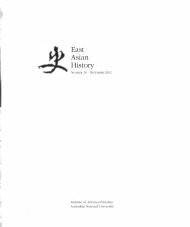Mujaku Dochu (1653-1744) and 17th-Century ... - East Asian History
Mujaku Dochu (1653-1744) and 17th-Century ... - East Asian History
Mujaku Dochu (1653-1744) and 17th-Century ... - East Asian History
Create successful ePaper yourself
Turn your PDF publications into a flip-book with our unique Google optimized e-Paper software.
MUJAKU DOCHU (<strong>1653</strong>-<strong>1744</strong>) AND SEVENTEENTH<br />
CENTURY CHINESE BUDDHIST SCHOLARSHIP<br />
John Jorgensen<br />
<strong>Mujaku</strong> <strong>Dochu</strong> 11!fl!B,'iS', can be considered one of the founders of Zengaku<br />
t$, the systematic scholarly research on Zen history, institutions, practices,<br />
regulations, literature <strong>and</strong> language. Zengaku appeared in name from around<br />
the 1890s as Hara Tanzan )]3::tJ3. ilJ (1819-92), Aizawa Ekai i'§i¥!(lij <strong>and</strong> Okada<br />
Giho [lilJEBILY! all had books published in the period 1907 to 1909 with Zengaku<br />
in the title.l However, it had its roots primarily in <strong>Mujaku</strong>, <strong>and</strong> possibly in<br />
Dokuan Genko 19i1i:::7\:; (1630-98) <strong>and</strong> Ban'an Eishu f-itfl (1591-1654),<br />
<strong>and</strong> in several slightly later Zen scholar-monks such as Menzan Zuiho 00 ilJ<br />
:fffij1J (1683-1769) <strong>and</strong> Torei Enji J!gJtlfIl (1721-92) 2 This Meiji period<br />
development parallels the rise of Zenshiso t$JG(;tJ( or "Zen thought" which<br />
derived largely from D.T. Suzuki **ttfl (1870-1960) <strong>and</strong> Nishida Kitaro iffi<br />
EBm!H (1870-1945).3 <strong>Mujaku</strong>'s scholarship was crucial for the development<br />
of Zengaku, as is evident in the diffusion <strong>and</strong> publication of <strong>Mujaku</strong>'s huge<br />
dictionary of Zen monastic items <strong>and</strong> offices, the Dictionary of the Images <strong>and</strong><br />
This research has been conducted with the<br />
assistance of an Australian Research Council<br />
Discovery Grant.<br />
1 John Jorgensen, "Zen Scholarship: <strong>Mujaku</strong><br />
<strong>Dochu</strong> <strong>and</strong> His Contemporaries," Zenbunka<br />
kenkyitsho kiyo [Annual Report of the Institute<br />
for Zen Studies! 27 (December 2004):<br />
1-60, at pp.43-5; for Hara, see Tamura<br />
Koyu, Kindai Nihon no Bukkyoshatachi [The<br />
Buddhists of Early Modern Japan! (Tokyo:<br />
Nihon hoso shuppansha, 2005), pp.231-35.<br />
2 For Zuiho, see David E. Riggs, "Meditation<br />
for Laymen <strong>and</strong> Laywomen: The Buddha<br />
Samadhi UijuyU zanmai) of Menzan Zuiho,"<br />
in Zen Classics: Formative Texts in the <strong>History</strong><br />
ofZen Buddhism, eds Steven Heine <strong>and</strong> Dale<br />
S. Wright (Oxford: Oxford University Press,<br />
2006), pp.248, 251-52; <strong>and</strong> David E. Riggs,<br />
"The Life of Menzan Zuiho, Founder ofDogen<br />
Zen, "japan Review 16 (2004): 67-100, at pp.71,<br />
89, <strong>and</strong> 90, especially a quote of a remark<br />
by Kagamishima that "Menzan's work is the<br />
/beginning [oil doctrinal studies (shugaku)<br />
in Soto Zen, <strong>and</strong> it is his framework that has<br />
continued ... to define the field," <strong>and</strong> p.274,<br />
where he states that Zuiho's references were<br />
in a nearly modern style. But <strong>Mujaku</strong> had<br />
already been doing this. For Enji, <strong>and</strong>, in<br />
passing, Genko, see Michel Mohr, "Imagining<br />
Indian Zen: Torei's Commentary on the<br />
Ta -mo-IO-lo ch 'an ching <strong>and</strong> the Rediscovery<br />
of Early Meditation Techniques during the<br />
Tokugawa Era," in Heine <strong>and</strong> Wright, Zen<br />
Classics, pp.215-16. For Genko, see also<br />
Ibuki Atsushi, Zen no rekishi [A <strong>History</strong> of<br />
Zen! (Kyoto: Hozokan, 2001), p.262; Helen<br />
J. Baroni, Obaku Zen: The Emergence of<br />
the Third Sect of Zen in Tokugawa japan<br />
(Honolulu: University ofHawai'i Press, 2000),<br />
pp.34-5; Okada Giho, Nihon Zensekishiron:<br />
Soto Zen hen [Historical Notes on Japanese<br />
Zen Texts: Soto Zen! (Tokyo: Ida shoten,<br />
1943), YoU, pp.296--97, 300-2, 319. For<br />
Eishu, see Sakai Tokugen, et aI., "Kaidai"<br />
[Explanation of Title! in Komazawa Daigaku<br />
Bungakubu Kokubungaku Kenkyushitsu,<br />
comp., Zenrin ruiju satsuyoshO [Selected<br />
Japanese Commentaries on the Categorised<br />
Phrases of the Zen Monasteries! Zenmon<br />
shomono sokan (Tokyo: Kyuko shoin, 1975),<br />
Vo1.6, pp.506--7, 509, <strong>and</strong> Okada, Nihon<br />
Zenseki shiron, YoU, pp.236--51.<br />
3 See Mohr, "Imagining Indian Zen," p.216.<br />
25

















